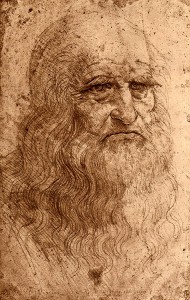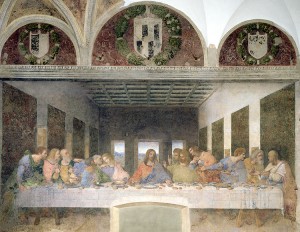Leonardo da Vinci 500
Friday, May 3rd, 2019May 3, 2019
On May 2, 1519—500 years ago yesterday—the famed Italian artist Leonardo da Vinci died at age 67 in the French town of Amboise. Leonardo, as he is almost always called, was one of the greatest painters and most versatile geniuses in history. He was also a key figure of the Renaissance, a great cultural movement that began in Italy in the 1300′s. His portrait Mona Lisa and his religious scene The Last Supper rank among the most famous pictures ever painted.

The Italian artist Leonardo da Vinci died 500 years ago yesterday on May 2, 1519. Credit: Red chalk (about 1514); Biblioteca Reale, Turin, Italy (© Ernani Orcorte, Alamy Images)
Exhibitions marking the 500th anniversary of Leonardo’s death are taking place in museums around the world, particularly in his native Italy. (Leonardo lived most of his life in Florence and Milan before moving to France late in life.) In Milan, “Leonardesque” events in 2019 include special presentations of The Last Supper at the monastery of Santa Maria delle Grazie, Leonardo codices (manuscript volumes) at the Ambrosiana Library and at Sforza Castle, and reproductions of machines designed by Leonardo at the Da Vinci National Museum of Science and Technology. Prominent events are also taking place in Florence, London, New York City, Paris, Turin, and in the Loire Valley surrounding Leonardo’s final residence at the Château du Clos Lucé in Amboise.

Leonardo da Vinci’s painting The Last Supper shows the final meal that Jesus shared with his 12 apostles. Credit: The Last Supper (1495-1497), fresco by Leonardo da Vinci; Santa Maria delle Grazie, Milan, Italy (Bridgeman Images)
Leonardo was trained to be a painter. But his interests and achievements spread into an astonishing variety of fields that are now considered scientific specialties. Leonardo studied anatomy, astronomy, botany, geology, geometry, and optics, and he designed machines and drew plans for hundreds of inventions.

Leonardo da Vinci’s Mona Lisa is probably the most famous portrait ever painted. Credit: Mona Lisa (1503-1506), oil on poplar wood by Leonardo da Vinci; Louvre Museum (Paris)
Because Leonardo excelled in such an amazing range of areas of human knowledge, he is often called a universal genius. However, he had little interest in literature, history, or religion. He formulated a few scientific laws, but he never developed his ideas systematically. Leonardo was most of all an excellent observer. He concerned himself with what the eye could see, rather than with purely abstract concepts. Leonardo was born on April 15, 1452, probably outside the village of Vinci, near Florence, in central Italy. The name da Vinci simply means from Vinci.


